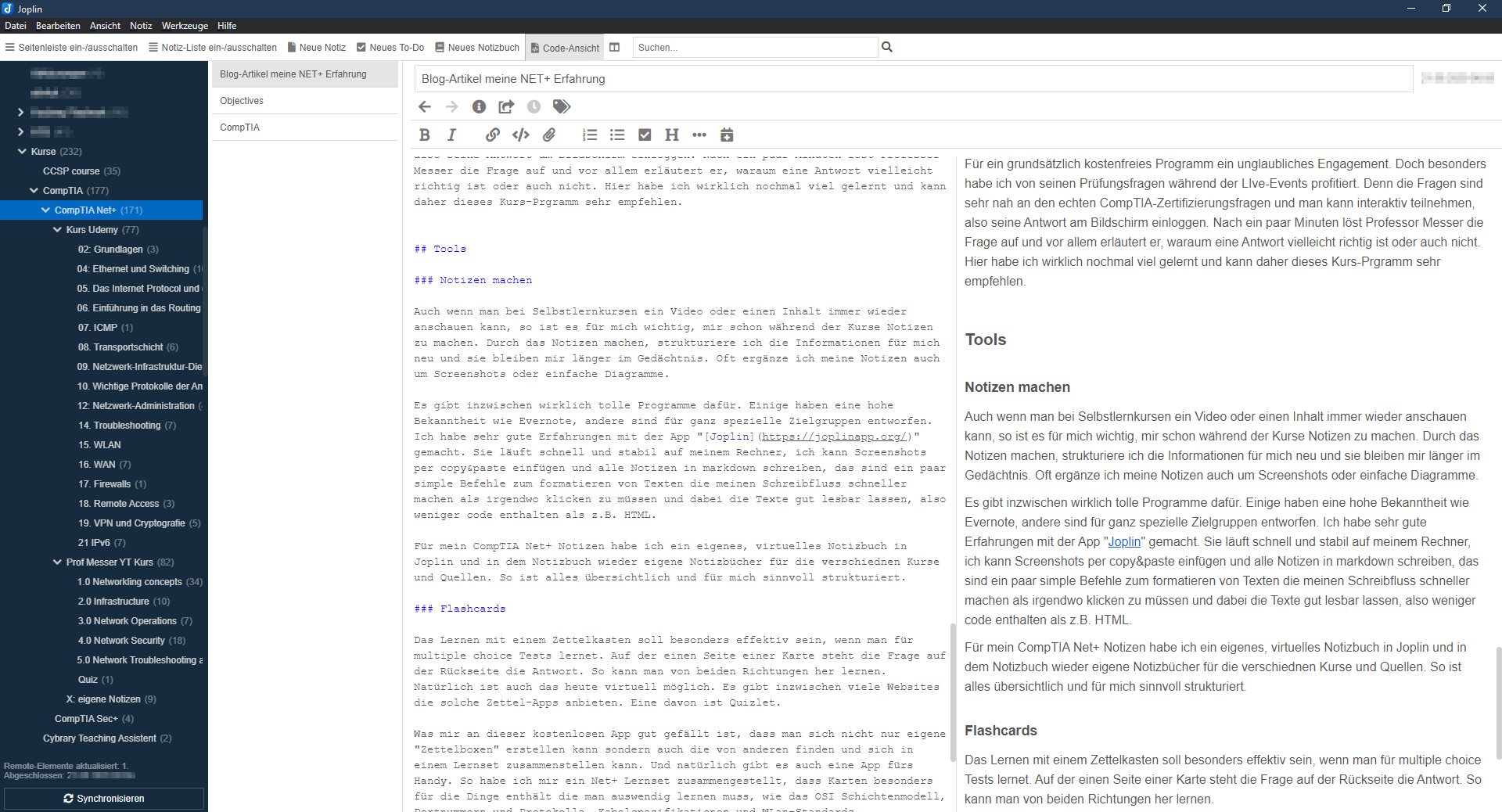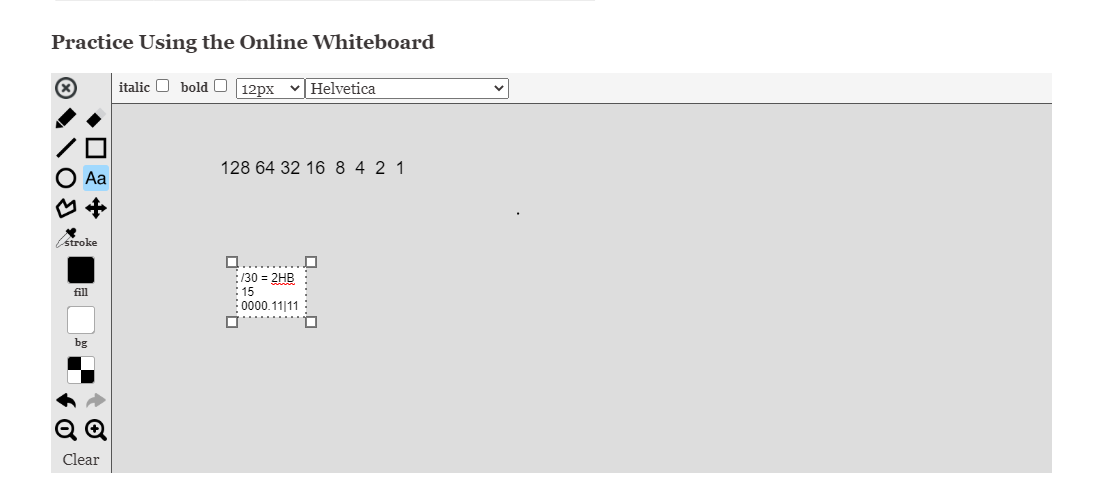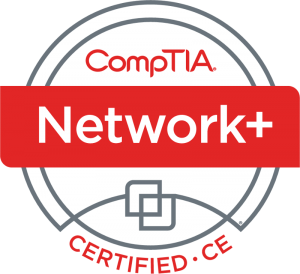The CompTIA certificate is considered a more basic certificate. But even as I have 20+ years of practical know how in the IT business, this was no easy one for me. I would consider it a lot harder then the CompTIA Security+ exam that I have passed before, especially as in Network+ it is not so much about concepts and logical connections, but there is also some math and knowing by heart involved.
So I putted for you the 5 tips in this article, which helped me the most to pass the Network+ exam.
TL;DR
- Decide your strategy before you start learning: passing the exam as fast as possible vs. laying a solid foundation for things to come
- Learning for the exam in English language might be beneficial even if you are no native speaker
- Prof. Messer has a great online course for this exam and the monthly live session is invaluable
- Give Joplin a try if you are looking for a great note taking app
- Crowdsourced flashcards on Quizlet are not just fun to learn but also an amazing tool to get the confidence to be ready for the test
- Try my game script written for bash to learn subnetting
- Before the exam, try the whiteboard app in the CompTIA software to use it effectively
Setting
But first let’s check the overall setting, so that you can benefit the most out of these tips.
It seems that there are two basic strategies how to tackle certifications in general:
- Buying a voucher for the exam and booking the date right away. This will force you to keep learning and lazy days are no issue, as the date is set.
- Learn the content in detail, figure out the connections and try to get to a point where you feel confident that you will pass the exam.
Obviously the first strategy is by far faster and more efficient. But if your goal is to really, really understand the fundamentals to build upon later on, the second way might be the one for you as well, just as it was for me at the time.
So I have no speed learning tips for you in this article, but tools and information to get the most out of the learning process.
Tip 1: mind the language
Also that I’m no native speaker, I finally decided to go with the English version for the exam. The Security+ exam at the time was only available in English language but the Network+ is also in German.
This is why I first bought the online course "Computer-Netzwerke (CompTIA Network+) – der umfassende Kurs" from Eric Amberg in German language. I thought that it might be easier for me to understand complex topic in my native language.
But I missed the point, that far more technical information is available in English language and that the translations of some terms into German language made it even harder for me to understand the concepts. Most documentations are written in English and I’m also mostly used to the English terms.
That’s why I would recommend to learn at least in English language and pass the exam also in English if you feel comfortable with it as well.
Tip 2: self-paced online training
As mentioned before, one of my objectives was to learn in my own pace. That’s why I really like self-paced online training.
One issue I had this time is to come to a point where I felt ready for the exam.
For the Security+ certification I bought a very good course from Mike Meyers. It had some training exams in it and passing them gave me the confidence to be ready for the real one.
Also the course from Eric Amberg (see tip 1) contains some questions between chapters to test your progress. But it didn’t felt like real exam questions to me. This why I decided to book another course before the exam and this time in English language (see tip 1).
As I hadn’t had another coupon for a course from Mike Meyers, I did go with the free version of the course from Prof. Messer on YouTube. If you want to watch the videos offline or get additional learning materials, you can buy one of the course packages he offers, but you don’t have to.
Prof. Messer was already recommended to me in the course "Practical Ethical Hacking – The Complete Course" by The Cyber Mentor on Udemy and has a really unique style to explain things, which made it easy for me to understand also complex topics.
One highlight for me are his monthly online learning groups, where he gets live on YouTube and answers real questions asked on the phone and makes quizzes about Network+-topics. Even this is free of charge, which I think is an amazing gift he makes to the community. Can’t recommend him enough.
Tip 3: taking notes
One thing I learned early on about hacking was: "if you don’t have a screenshot, it didn’t happen".
So note taking became very important to me. It’s also well known that things we write down remain longer available in our brain.
I used one very popular note taking app for some years before, but it had some issues: content was not encrypted but in the cloud, no markdown which I really like to have for fast formating while typing and a subscription based business model which I don’t like much.
Most build-in offline editors on the other hand, do not offer to paste screenshots in or easily create links to attachments.
One app that really suits all my needs and served me very well while learning for the Network+ exam was Joplin. Besides that it’s open source, it is crammed with features and gets heavily developed by an active community. Maybe worth to check it, if you are looking for a good note taking app in the IT space.

Tip 4: using crowd-sourced flashcards
Flashcards are also considered a highly effective learning tool for multiple choice tests. There are a lot of Apps and websites available offering virtual flashcards and one of them is called "Quizlet.
It stands out to me as you don’t just have the possibility to create your own sets of flashcards, but to share your sets with others students. That’s why you find already a lot of ready to use sets to prepare also for the Network+ exam.
Yes, some have better quality then others but this is most times quite obvious. If you live in the U.S. you might even buy the offical set from CompTIA to be on the safe side. For me in Europe it wasn’t possible, even when I involved the support.

So I created my own set combined with sets of other users, especially for things I had to know by heart like cable standards, port numbers or different data throughput in 802.11 standards, but also with demo questions which are very exam like.
I liked that you have to answer a question multiple times right, before it’s marked as learned. So when I came to the point where all questions have been marked as learned, I had good confidence to take the real exam.
Btw. learning with Quizlet is also fun as you can play some kind of games to learn your sets. Some of these games have a time limit, so that you can train to handle the time pressure in the exam as well.
If you want, you can also use my learning set for free at Quizlet
Tip 5: learn subnetting with my quiz script
There is also a set of flashcards in my Quizlet stack for subnetting, but this is nothing you can learn by heart.
Subnetting, so chunking a range of IPs into subnets, you need to understand to do it right.
Prof. Messer has method of "7 Sec. Subnetting" which is helpful to know for the exam. But also this way I didn’t got the calculation method yet.
So I wrote me a small bash script which picks randomly one of three typical question scenarios regarding subnetting and a random IP-range.
The right answer will be visualized after a given delay, using an amazing Perl lib from Krischan Jodies, so that you can do your own math in between and compare the results.

This made it easier for me to put some handles on this fairly complex topic. If you want to use it, you can get it also for free on GitHub.
Bonus-Tip: use a timer for training
Learning beside family, work and daily life is not an easy thing. In a world of still almost endless possibilities how to spend your time, prioritizing time to learn is a challenge.
I made really good progress when I started to learn every day at the same time. When I reserved a spot in my morning routine to watch some videos of the course. And I really set a timer for it. Only when the preset time was up, I continued with my daily routine.
Newer research indicates that the well known Pomodoro technique is not the best option for this, due to cycle of neurotransmitters that are emitted when we learn. Most research recommends now intervals of 90 minutes.
Today every smartphone has a timer but I used an online app in a browser tab, I never closed. This way I also had a visual reminder for my learning routine. You can find one at webuhr.de
About the online exam of CompTIA
When I passed my Security+ exam there was no possibility yet, to do it online. I had to take a day of and drive 50 km to the next bigger city to sit in front of a computer there. This I considered an additional invest beside the money for the voucher, which I had to take into consideration.
So now, maybe also due to COVID-19, finally you can pass the CompTIA exam online and I think this is great. As with all other exams I passed before online, you have to download and install a small piece of software, which avoids that you use any other program during the exam. You are also proctored via webcam during the time.
Whiteboard
CompTIA is quite strict with the rules during the exam. You are not allowed to drink, leave the room or even have a pen an paper for notes on your desk.
The later was a problem for me, as e.g. for fast subnetting (see Tip 5) a piece of paper was required for me.
The app has some kind of whiteboard functionality for it, but I was not sure if it will work as well for me. The only information I found at first was some pdf with instructions on how to use the whiteboard app.
I also found one MBA.com:
Please note: if you have a touchscreen laptop, you may not use a stylus, your finger, or other writing apparatus to write on the whiteboard. The online whiteboard cannot be used with a connected writing tablet or pad, nor can you use dual monitors for taking the exam and accessing the whiteboard.
So only keyboard, no handwriting and the limited screen estate. Lucky me, I found some demo of the whiteboard app so I could test it a little in advance and get comfortable with it.

During the exam, I had the issue that I couldn’t close the window with the whiteboard anymore. As I wanted to stick with my concentration, I decided to not ask the proctor about it but to drag it on the edge of the screen, which worked for me.
Preparation checklist
I used this checklist provided by CompTIA before the exam and think it is quite useful:
- Run the system test. All candidates must verify minimum system requirements and run the system test before scheduling an OnVUE exam.
- Connect using a strong, reliable internet connection.
- Do NOT switch computers. Take your exams on the same network and computer used for the system test.
- Close all other applications. The secure browser used for your exam requires that you close all applications except OnVUE. Failing to do so will interrupt your exam.
- Check your time zone preferences! When scheduling your online exam the time you choose will correspond to the time zone set within your Pearson VUE candidate account preferences. Confirm the time zone set in your profile is the one you intend.
Synopsis
While learning for my CompTIA Network+ exam, I learned more then interesting networking contents and concepts. I also learned something about the process to come to a successful exam and ways to learn effectively in a world changed by a global pandemic. I shared my insights with you in this article and if you found something useful in it, I would be happy to connect on LinkedIn.

